Research Topics
- The Kinetics of the Glass Transition
- Properties and Reactions at the Nanoscale
- The Viscoelastic Bulk Modulus of Polymers and Nanocomposites
The Kinetics of the Glass Transition
Glasses are inherently non-equilibrium materials, and consequently, their properties evolve toward equilibrium in a process known as structural recovery or physical aging. We use calorimetry and dilatometry to study the kinetics associated with the glass transition and have studied a variety of glass formers ranging from selenium to chalcogenide glasses to polymeric glasses, such as polystyrene. Along with our experiments, we perform modeling work to understand the essential physics underlying structural recovery and to develop more predictive models of structural recovery and physical aging. To this end, we have developed a unique temperature perturbation experiment that allows us to directly test assumptions underlying the current models of structural recovery. This work is important because although the volume changes associated with structural recovery are small, being typically less than 0.1 %, ultimate properties, such as failure modes and lifetimes, are often very negatively impacted. Our aim of providing a better understanding of structural recovery will facilitate the use and design of glasses in engineering applications.
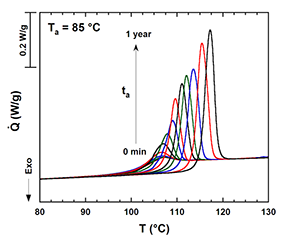
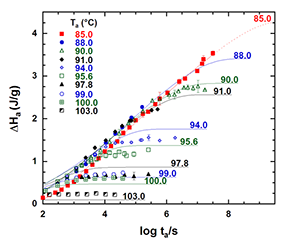
DSC heat flow curves in the figure on the left show the evolution of the enthalpy overshoot as aging progresses for polystyrene at 85 °C. From these data and similar data at other temperatures, the enthalpy change on aging versus logarithmic time is determined, as shown on the right. Enthalpy changes progress smoothly within the error of the measurements and level off when equilibrium is reached. The time required to reach equilibrium increases as aging time decreases. At 85 °C, aging for one year is insufficient to reach equilibrium. Macromolecules 2013, 46, 5815-5821.
Properties and Reactions at the Nanoscale
The behavior of materials confined to nanoscale dimensions has been of considerable interest over the past two decades. Recent work in our laboratory has focused on the influence of nano-confinement on the glass transition and associated kinetics using calorimetry. Various confinement systems have been investigated, including small molecule
and polymeric glass-formers confined to nanopores, glass-formers confined by crystalline domains, and stacked ultra-thin films. Recently we have used ultrafast scanning chip calorimetry to study single ultra-thin films having sample sizes of less than 100 ng. The single thin films are of particular interest because they show a Tg depression
that not only depends on cooling rate but that can be reversed by film dewetting and thickening during high-temperature annealing. The aim of the work is to determine the influence of surface and interface effects relative to instrinsic size effects.
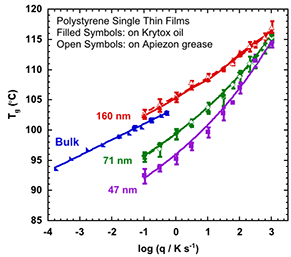
The influence of cooling rate q on the Tg depression of a single polystyrene thin film measured using chip calorimetry. The Tg depression becomes more significant as cooling rate decreases. Macromolecules, 2013, 46, 562−570.
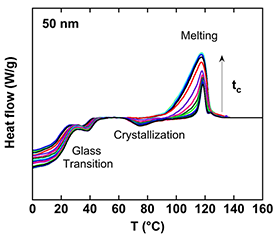
A small molecule glass-former confined in 50 nm pores shows two Tgs, one associated with the pore surface and a lower one associated with the pore center. Both Tgs decrease as crystallization progresses. Journal of Physical Chemistry B 2012, 116, 7754−7761
In addition to studying the glass transition at the nanoscale, we are also interested in changes in the kinetics and thermodynamics of nanoconfined polymerization reactions. In the case of step-growth polymerization of cyanate esters and free radical polymerization of methyl methacrylate, we find enhanced reactivity with decreasing nanopore size.
On the other hand, in the ring-opening polymerization of dicyclopentadiene, we find reduced reactivity and the presence of a side reaction not present in the bulk system. The results can generally be explained and modeled by competition between changes in local packing and diffusivity under confinement coupled with entropic and surface
effects.
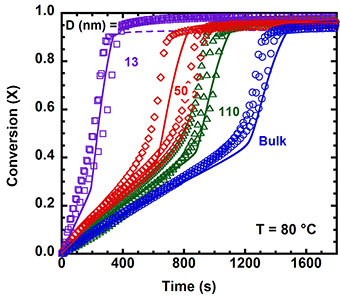
The free radical polymerization of MMA in native nanopores is accelerated for two reasons:
i) the surface silanol groups catalyze the reaction and decreases in chain diffusion
ii) results in more free radicals and earlier onset of autoacceleration. Polymer 2012, 53, 3238-3244.
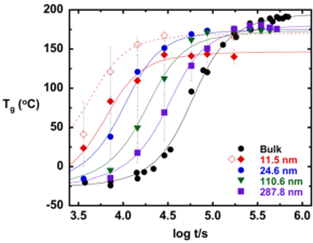
Reaction kinetics for trimerization of dicyanate ester to form a polycyanurate network are followed by the increase in Tg. The reaction occurs over an order of magnitude faster in 11 nm pores. Macromolecules 2008, 41, 1310-1317.
The Viscoelastic Bulk Modulus of Polymers and Nanocomposites
The relationship between the viscoelastic bulk and shear moduli has been debated for the last fifty years since Leaderman’s suggestion that the two responses arise from different molecular mechanisms. We have used a unique pressurizable dilatometer to study the pressure-volume-temperature (PVT) behavior and the viscoelastic bulk modulus
of linear and star polystyrenes, a polystyrene nanocomposite, and two polycyanurates. We find that although there is quantitative agreement between the slopes of the retardation spectra for the bulk and shear responses at short times, the long-time chain mechanisms available to the shear response are not available to the bulk response. This latter point, that chain modes are unavailable to the bulk response, was also recognized by Markovitz and by Berry and Plazek; in fact, much of the apparent controversy concerning the origin of the bulk and shear responses may arise from this detail. The investigations are of practical importance since the time-dependent bulk modulus is responsible for the magnitude of isotropic residual stresses incurred in confined resins, including in thick composite parts, and in polymer processing.
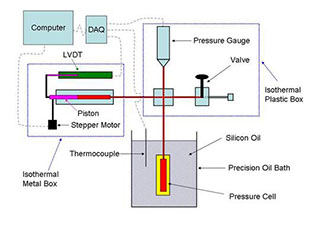
Schematic of the unique pressurizable dilatometer. Review of Scientific Instruments 2009, 80, 053903
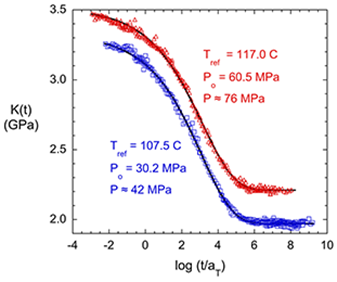
Master curves for the viscoelastic bulk modulus of polystyrene at two pressures. Review of Scientific Instruments 2009, 80, 053903.